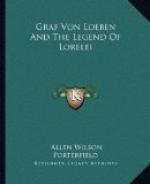The most plausible theory in regard to the source of Heine’s ballad is the one proposed by Oscar F. Walzel, who says: “Heine hat den Stoff wahrscheinlich aus dem ihm wohlbekannten Handbuch fUer Reisende am Rhein von Aloys Schreiber Uebernommen."[61] The only proof that Walzel gives that Heine knew Schreiber’s manual is a reference[62] to it in Lutetia. But this was written in 1843, and proves nothing as to 1823. His contention, however, that Heine borrowed from Schreiber[63] has everything in its favor, from the point of view of both external and internal evidence and deserves, therefore, detailed elaboration.
As to internal evidence, there is only one slight difference between Heine’s ballad and Schreiber’s saga: where Heine’s Lorelei combs her hair with a golden comb and has golden jewelry, Schreiber’s “bindet einen Kranz fUer ihre goldenen Locken” and “hat eine Schnur von Bernstein in der Hand.” Even here the color scheme is the same; otherwise there is no difference: time, place, and events are precisely the same in both. The mood and style are especially similar. The only words in Heine not found in Schreiber are “Kamm” and “bedeuten.” Schreiber goes, to be sure, farther than does Heine: he continues the story after the death of the hero.[64] This, however, is of no significance, for Heine was simply interested in his favorite theme of unrequited or hindered love.
Now Heine must have derived his plot from somewhere, else this would be an uncanny case of coincidence. And the two expressions, “Aus alten Zeiten,” and “Mit ihrem Singen,” the latter of which is so important, Heine could have derived only from Schreiber. Heine was not jesting when he said it was a fairy tale from the days of old; he was following, it seems, Schreiber’s saga, the first sentence of which reads as follows: “In alten Zeiten liess sich manchmal auf dem Lureloy um die AbenddAemmerung und beym Mondschein eine Jungfrau sehen, die mit so anmuthiger Stimme sang, dass alle, die es hOerten, davon bezaubert wurden.” But Brentano’s Lorelei does not sing at all, and Loeben’s just a little, “Sie singt dir hold zum Ohre,” while Heine, like Schreiber, puts his heroine in the prima donna class, and has her work her charms through her singing. And it seems that Heine was following Schreiber when the latter wrote as follows: “Viele, die vorUeberschifften, gingen am Felsenriff oder im Strudel zu Grunde, weil sie nicht mehr auf den Lauf des Fahrzeugs achteten, sondern von den himmlischen TOenen der wunderbaren Jungfrau gleichsam vom Leben abgelOest wurden, wie das zarte Leben der Blume sich im sUessen Duft verhaucht.”
And as to her personal appearance, Brentano and Loeben simply tell us that she was beautiful, Brentano employing the Homeric method of proving her beauty by its effects. Heine and Schreiber not only comment upon her physical beauty, they also tell us how she enhanced her natural charms by zealously attending to her hair and her jewelry and religiously guarding the color scheme in so doing. In brief, the similarity is so striking that, if we can prove that Heine knew Schreiber in 1823, we can definitely assert that Schreiber[65] was his main, if not his unique, source.




